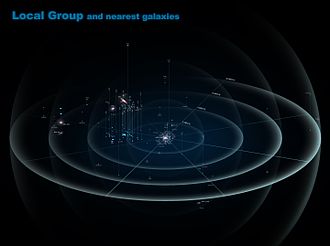| Local Group | |
|---|---|
 Local Group of galaxies, including the massive members Messier 31 (Andromeda Galaxy) and Milky Way, as well as other nearby galaxies. | |
| Observation data (Epoch J2000) | |
| Parent structure | Virgo Supercluster |

The Local Group is the galaxy group that includes the Milky Way, where Earth is located. It has a total diameter of roughly 3 megaparsecs (10 million light-years; 9×1019 kilometres),[1] and a total mass of the order of 2×1012 solar masses (4×1042 kg).[2] It consists of two collections of galaxies in a "dumbbell" shape; the Milky Way and its satellites form one lobe, and the Andromeda Galaxy and its satellites constitute the other. The two collections are separated by about 800 kiloparsecs (3×106 ly; 2×1019 km) and are moving toward one another with a velocity of 123 km/s.[3] The group itself is a part of the larger Virgo Supercluster, which may be a part of the Laniakea Supercluster. The exact number of galaxies in the Local Group is unknown as some are occluded by the Milky Way; however, at least 80 members are known, most of which are dwarf galaxies.
The two largest members, the Andromeda and the Milky Way galaxies, are both spiral galaxies with masses of about 1012 solar masses each. Each has its own system of satellite galaxies:
- The Andromeda Galaxy's satellite system consists of Messier 32 (M32), Messier 110 (M110), NGC 147, NGC 185, Andromeda I (And I), And II, And III, And V, And VI (also known as the Pegasus Dwarf Spheroidal Galaxy, or Pegasus dSph), And VII (a.k.a. the Cassiopeia Dwarf Galaxy), And VIII, And IX, And X, And XI, And XIX, And XXI and And XXII, plus several additional ultra-faint dwarf spheroidal galaxies.[4]
- The Milky Way's satellite galaxies system comprises the Sagittarius Dwarf Galaxy, Large Magellanic Cloud, Small Magellanic Cloud, Canis Major Dwarf Galaxy (disputed, considered by some not a galaxy), Ursa Minor Dwarf Galaxy, Draco Dwarf Galaxy, Carina Dwarf Galaxy, Sextans Dwarf Galaxy, Sculptor Dwarf Galaxy, Fornax Dwarf Galaxy, Leo I (a dwarf galaxy), Leo II (a dwarf galaxy), Ursa Major I Dwarf Galaxy and Ursa Major II Dwarf Galaxy, plus several additional ultra-faint dwarf spheroidal galaxies.[5]

The Triangulum Galaxy (M33) is the third-largest member of the Local Group, with a mass of approximately 5×1010 M☉ (1×1041 kg), and is the third spiral galaxy.[6] It is unclear whether the Triangulum Galaxy is a companion of the Andromeda Galaxy; the two galaxies are 750,000 light years apart,[7] and experienced a close passage 2–4 billion years ago which triggered star formation across Andromeda's disk. The Pisces Dwarf Galaxy is equidistant from the Andromeda Galaxy and the Triangulum Galaxy, so it may be a satellite of either.[8]
The other members of the group are likely gravitationally secluded from these large subgroups: IC 10, IC 1613, Phoenix Dwarf Galaxy, Leo A, Tucana Dwarf Galaxy, Cetus Dwarf Galaxy, Pegasus Dwarf Irregular Galaxy, Wolf–Lundmark–Melotte, Aquarius Dwarf Galaxy, and Sagittarius Dwarf Irregular Galaxy.[9]
The membership of NGC 3109, with its companions Sextans A and the Antlia Dwarf Galaxy as well as Sextans B, Leo P, Antlia B and possibly Leo A, is uncertain due to extreme distances from the center of the Local Group.[3] The Antlia-Sextans Group is unlikely to be gravitationally bound to the Local Group due to probably lying outside the Local Group's Zero-velocity surface—which would make it a true galaxy group of its own rather than a subgroup within the Local Group.[10] This possible independence may, however, disappear as the Milky Way continues coalescing with Andromeda due to the increased mass, and density thereof, plausibly widening the radius of the zero-velocity surface of the Local Group.
- ^ Redd, Nola Taylor (18 December 2017). "Astronomers track dwarf galaxies to better understand the Milky Way's make-up and evolution". Proceedings of the National Academy of Sciences. 115 (51): 12836–12838. doi:10.1073/pnas.1817136115. PMC 6304947. PMID 30568025. S2CID 58645004.
- ^ The mass of the Local Group is essentially accounted for by the mass of the Milky Way and the Andromeda Galaxy. Estimates for the mass of each galaxy are compatible with 1012 M☉, and Peñarrubia et al. (2014) estimate (2.3±0.7)×1012 M☉ for the Local Group, but Karachentsev and Kashibadze (2006) estimate the somewhat lower value of (1.29±0.14)×1012 M☉.
- ^ a b Karachentsev, I. D.; Kashibadze, O. G. (2006). "Masses of the local group and of the M81 group estimated from distortions in the local velocity field". Astrophysics. 49 (1): 3–18. Bibcode:2006Ap.....49....3K. doi:10.1007/s10511-006-0002-6. S2CID 120973010.
- ^ Kalirai, Jason S.; Beaton, Rachael L.; Geha, Marla C.; Gilbert, Karoline M.; Guhathakurta, Puragra; Kirby, Evan N.; Majewski, Steven R.; Ostheimer, James C.; Patterson, Richard J. (17 February 2010). "The Splash Survey: Internal Kinematics, Chemical Abundances, and Masses of the Andromeda I, Ii, III, Vii, X, and Xiv Dwarf Spheroidal Galaxies". The Astrophysical Journal. 711 (2): 671–692. arXiv:0911.1998. Bibcode:2010ApJ...711..671K. doi:10.1088/0004-637X/711/2/671. ISSN 0004-637X. S2CID 43188686.
- ^ Sergey E. Koposov; Vasily Belokurov; Gabriel Torrealba; N. Wyn Evans (10 March 2015). "Beasts of the Southern Wild. Discovery of a large number of Ultra Faint satellites in the vicinity of the Magellanic Clouds". The Astrophysical Journal. 805 (2): 130. arXiv:1503.02079. Bibcode:2015ApJ...805..130K. doi:10.1088/0004-637X/805/2/130. S2CID 118267222.
- ^ "The Local Group". NASA's High Energy Astrophysics Science Archive Research Center (HEASARC). NASA. Retrieved 5 May 2015.
- ^ "Messier Object 33". www.messier.seds.org. Retrieved 21 May 2021.
- ^ Miller, Bryan W.; et al. (December 2001). "The Star Formation History of LGS 3". The Astrophysical Journal. 562 (2): 713–726. arXiv:astro-ph/0108408. Bibcode:2001ApJ...562..713M. doi:10.1086/323853. ISSN 0004-637X. S2CID 119089499.
- ^ McConnachie, Alan W. (2012). "The observed properties of dwarf galaxies in and around the Local Group". The Astronomical Journal. 144 (1): 4. arXiv:1204.1562. Bibcode:2012AJ....144....4M. doi:10.1088/0004-6256/144/1/4. S2CID 118515618.
- ^ van den Bergh, Sidney (June 1999). "The Nearest Group of Galaxies". The Astrophysical Journal. 517 (2): L97–L99. arXiv:astro-ph/9904425. Bibcode:1999ApJ...517L..97V. doi:10.1086/312044.